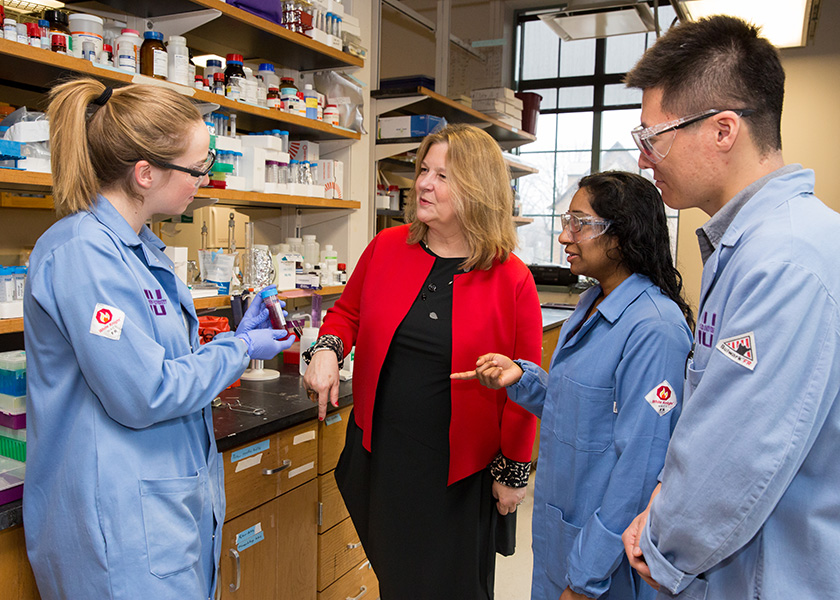Biorefinery Uses Microbial Fuel Cell to Upcycle Resistant Plant Waste
Organic waste turns into antioxidant flavonoids for nutrition and medicine

When nature designed lignin — the fibrous, woody material that gives plants their rigid structure — it didn’t cut any corners. Incredibly slow to break down, lignin is so sturdy and long lasting that it is resistant to bacteria and rot.
So, what happens to all the lignin waste from farmlands, breweries, and paper mills? Most of it is burned or buried, generating pollution, and wasting a potential renewable resource.
Now, Northwestern Engineering researchers have developed a sustainable, inexpensive two-step process that can upcycle organic carbon waste — including lignin. By processing waste through a microbe-driven biorefinery, the researchers turned lignin into carbon sources that could be used in high-value, plant-derived pharmaceuticals, and antioxidant nutraceuticals as well as carbon-based nanoparticles for drug or chemical delivery.
The study was featured on the cover of the January issue of the journal ACS Sustainable Chemistry and Engineering.

“Lignin should have tremendous value, but it’s intrinsically regarded as waste,” said the McCormick School of Engineering’s Kimberly Gray, who led the research. “Lignin makes up 20-30 percent of biomass but 40 percent of the energy, which is a lot, but it’s difficult to tap this energy source. Nature made lignin so recalcitrant to processing that people haven’t figured out how to use it. Researchers have been trying to solve this problem for decades. Using an oil refinery as a template, we developed a biorefinery that takes in waste streams and produces high-value products.”
Gray is the Roxelyn and Richard Pepper Family Chair in Civil and Environmental Engineering and professor of civil and environmental engineering at the McCormick School of Engineering.
Nature’s building material
One of the most abundant organic polymers in the world, lignin is present in all vascular plants. Found between cell walls, lignin gives strong, sturdy plants — like trees —structural support. Without lignin, wood and bark would be too weak to support trees. And wooden houses and furniture would simply collapse.
But most industries that use plants — such as the paper manufacturing and brewing industries — strip out lignin, leaving behind cellulose, a type of sugar. Instead of making use of nature’s ultra-resistant material, industrial teams burn lignin as a cheap fuel.

“Humans want to get rid of lignin to reach the sugars,” Gray said. “They ferment cellulose to make alcohol or process it to make pulp. Then what do they do with the lignin? They burn it as a low-quality fuel. It’s a waste.”
Bacteria-powered fuel cell
To develop a biorefinery for breaking down carbon waste, including lignin, the researchers first engineered a microbial electrolysis cell (MEC). Similar to a fuel cell, the MEC exchanges energy between an anode and a cathode. But instead of a metal-based anode, Northwestern’s bio-anode comprises exoelectrogens — a type of bacteria that naturally generate electrical energy by eating organic matter.
“The microbes act as the catalyst,” said study co-author George Wells, associate professor of civil and environmental engineering. “Instead of using chemical catalysts, which are often very expensive and require high temperatures, we’re using biology as the catalyst.”
The beauty of the MEC is that it can process any type of organic waste — human, agricultural, or industrial. The MEC cycles waste-filled water through the bacteria, which eat up the carbon. Here, they degrade the organic carbon into carbon dioxide and then naturally respire electrons.
During this process, extracted electrons flow from the bio-anode to the cathode (made of a carbon cloth), where they reduce oxygen to generate water. The process consumes protons, driving up the water’s pH to turn it into a caustic solution. From there, the caustic solution could be used for any number of applications, including wastewater treatment.
The microbes act as the catalyst. Instead of using chemical catalysts, which are often very expensive and require high temperatures, we’re using biology as the catalyst.
George WellsAssociate Professor of Civil and Environmental Engineering
“Another benefit of this process is that it effectively treats wastewater to remove detrimental organic carbon,” Wells said. “So, a key product is clean water.”
But the researchers took the caustic substance and turned their attention back to the lignin. Lignin compounds are durable because they contain complex chains of aromatic carbon, which have a special bonding pattern that forms a ring of six carbon atoms. Each aromatic ring comprises alternating double and single bonds, which are incredibly difficult to break apart.
Busting ‘unbreakable’ bonds
When the researchers exposed lignin to the bio-based caustic chemical, however, lignin’s polymers broke apart in a way that preserved the aromatic rings. About 17 percent of the processed lignin turned into rings of carbon called flavonoids, an antioxidant-rich phytonutrient often found in supplements. Commonly used in medicinal chemistry, these rings could be used as plant-derived, sustainable precursors to inexpensive pharmaceuticals and supplements.
“It breaks apart the polymer bonds but selectively leaves the ring,” Gray said. “If you can preserve that ring, then you can make high-value materials. Chemists have developed catalysts that break apart the whole compound, and then they have to rebuild the ring. But we were able to break it selectively to preserve the valuable structures.”
The rest of the processed lignin (about 80 percent) became carbon-based nanoparticles, which could be used to encompass substances for targeted drug delivery in humans or targeted nutrient delivery in plants. The nanoparticles also could offer a sustainable, plant-derived alternative for sunscreens and cosmetics.
“It’s exciting to identify and explore a route for sustainable resource recovery from multiple waste streams,” Wells said. “We have massive wastewater and lignin streams that are expensive to treat on their own. We’re trying to reimagine those as sources of value.”
Recovering resources without hazardous chemicals
Although researchers could have used a commercially available caustic substance to process lignin, their MEC-based approach has many advantages. First, the green bio-based chemical just works better. Second, it’s safer, less expensive, can be used in ambient conditions, and can generate chemicals at the point of need.
“There are many caustic substances, such as sodium hydroxide, which is commonly used in many industrial processes and wastewater treatment,” Wells said. “But that involves shipping and storing large amounts of toxic chemicals. Not only is that expensive, it also is hazardous for public health. It’s much safer and more sustainable to generate chemicals on site from waste products. We avoid having to ship or store large quantities of hazardous chemicals and are not reliant on supply chains or trucks arriving on time. It gives us flexibility and adaptability to generate chemicals right on site when they are needed.”
The study, “Valorization of Lignin Under Mild Conditions: Biorefining Flavonoids and Lignin Nanoparticles,” was supported by the Finite Earth Initiative of the McCormick School of Engineering at Northwestern University.
View an overview of research in the Department of Civil and Environmental Engineering: